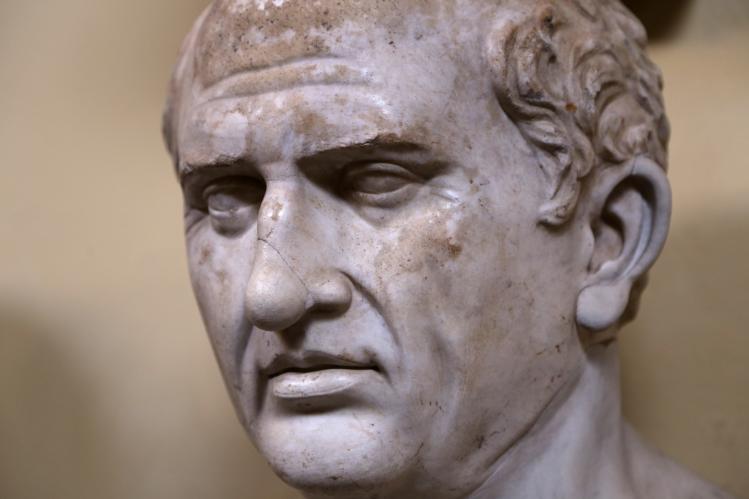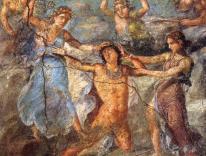
In the first pages of Oxford professor Nicola Gardini’s unapologetic paean to Latin literary craft, he defends the ancient Roman tongue against the perennial charge that it’s dead—or at best, zombified. “Latin is alive,” he pronounces, “and it’s more alive than what we tell our friend at the café or our sweetheart on the phone.” For Gardini, the metric of whether Latin still has a pulse is not the annual tally of spoken Latin conferences or the headcount of the schoolchildren chanting the forms of the third declension. Mere speech, he paradoxically contends, is the ephemeral substratum of a lifeless lingua, for “in this very moment the entire planet is jabbering, amassing an immeasurable heap of words. And yet those words are already gone. Another heap has already formed, also destined to vanish in an instant.”
It’s tempting to see Gardini’s claim as some clever Nietzschean inversion: “No, English, you’re the real dead language.” But Long Live Latin is more than Oxford sneering at contemporary chatter. It has a real argument: that we can find the lifeblood of Latin in those hushed volumes of Ovid and Petronius, of Sallust and Juvenal, all living because they “express spiritual nobility through linguistic excellence.” The book’s regular citations of Dante and Shakespeare, too, show how “linguistic excellence” is not the domain of the ancient Romans alone—these later authors are as undead as Catullus and Cicero. Not a defense of Latin per se, then, Gardini’s book pins the immortality of Latin precisely on its literary sublimity. And in our present era, an interminable Groundhog Day of regrettable tweets and focus-grouped bromides, Gardini’s careful exposition of Virgilian allusion and Tacitean abruptness indeed feels salutary, necessary, and yes, alive.
Undoubtedly, many will look at Gardini’s literary tribute as a totem of privilege and snobbishness: the high over the low, the refined over the primitive, the elite over the vulgar. Others, too, will see a willful omission of the violent imperialism underlying Roman culture. Such accusations would not be without merit, and it’s strange that Gardini accepts how “individual authors are only embodiments of [their] empirical conditions” but tells us so little about the conditions that brought about, for example, the Augustan leisure class. But if it is true that our own language is “signifying less and less, sounding more and more like white noise, like traffic, or like certain politicians,” then perhaps it would do us well to trade Twitter’s bird for Catullus’s sparrow and to listen attentively to the slow, deep heartbeat of latinitas.
Even if the fragmentary inscriptions in the cover illustration of Long Live Latin suggest an omnivorous survey of any and all texts surviving from antiquity, the book has little interest in the gravestones, tax receipts, and grammar exercises found in our libraries of ancient literature. These examples of what scholars today call “non-literary texts” are worthy of our study in their own right, of course, if we are to have any hope of grasping ancient political economy and Roman agricultural systems. But Gardini’s focus here is exclusively literary. When he speaks of “Latin,” he speaks “first and foremost...of a complete dedication to organizing one’s thoughts in a profound and measured discourse.”
Accordingly, aside from a few introductory sections on Latin’s origins and development, Gardini’s book is devoted to those authors who were most successful in producing such “profound and measured” language. This account, however, is no tired chronological slog of Cicero to Virgil to Ovid to Seneca. Long Live Latin instead bounces from Catullus, backward to Ennius, ahead to Tacitus, sideways to Augustine, finally to Gardini’s primus inter pares, Horace. The guiding principle is literary excellence, not a historical timeline.
This approach is clear, especially in the treatment of authors whose achievements extend well beyond literature. Always providing ample Latin block quotes and his own clear translations, Gardini shows readers how Cicero, for example, “demonstrates with enviable confidence his knowledge of which words most accurately describe reality” and deliver the strongest punch. Cicero prosecutes someone not as a mere adulterer (adulter) but instead as a “conquerer of chastity” (expugnator pudicitiae). In another quotation from his Philippics, Cicero employs “symmetry, repetition, and variation, in which the various inversions of meaning come to symbolize the spirit of protest and desire for retribution.” This presentation celebrates Cicero’s stylistic, rather than legal, accomplishments.
Gardini’s praise of Ciceronian prose is part of a long tradition—stretching back to antiquity itself—of seeing Rome’s most famous attorney-statesman as the pinnacle of Latinity. But he also gives ample attention to lesser-known masters. He highlights, for example, the “tendency to amass details that characterizes satirical Latin” in Juvenal, and he devotes an entire chapter to Virgil’s early pastoral Eclogues, showing how their “adynata, or logical impossibilities,” amount to an effort to “depict utopia,” a place that “cannot be confirmed by experience or memory.” Gardini even includes some early Christian authors, who are often sidelined in classics departments. In a chapter on Augustine’s “avant-garde, digressive, even visionary” use of imagery, he spotlights Tertullian, too, a pioneering Christian prose writer whose penchant for “paradox and oxymoron” still suffuses our own religious language.
By presenting undiluted accounts of linguistic novelty in Propertius and branching syntax in Livy, Gardini offers his readers an intellectualized, even outright academic account of Latin literature. Given this unabashed learnedness, I was surprised to see him announce in chapter one that his “is a book, above all, for young students.” Long Live Latin itself uses a sophisticated, wrought prose style throughout (elegantly translated from Gardini’s Italian by Todd Portnowitz), so it’s no easily digestible D’Aulaires’ Book of Greek Myths. The book’s stratospheric expectations for its young readership, however, are a potent selling point, for inasmuch as Long Live Latin is an enthusiast’s tribute to Horace and Apuleius, it is also a master class in how to read literature of any kind. Like an expert docent at the Met, Gardini leads the amateur Latinist through obscure allusions and metaphors. Using a similar visual analogy, in fact, Gardini remarks that “art is difficult, and Latin is art, verbal art, just as Picasso’s painting, Mozart’s music, or Einstein’s models of the universe are artistic constructions in their own ways.” An adolescent is unlikely to understand Picasso or Einstein without some guidance, and similarly, young people won’t grasp the architecture of Augustine’s prose unassisted.
The positioning of Latin among other emblems of high culture is likely to resurrect the charge of snobbery or even classism—the charge that for Gardini, Latin is a subject championed by, and reserved for, the well-to-do. But the explicit targeting of a young readership might be the best defense against such accusations. Where I grew up, for instance, there are no Latin teachers and no literature professors, and Gardini’s overtly intellectual chapters often made me think what a revelation this book would have been to me if I had read it as a teenager. In that sense, Long Live Latin may be suited less for the young person at the posh prep school in New York or New England. Classics and other humanistic disciplines continue to grapple with their inaccessibility to those outside these topmost echelons of privilege, and in the spirit of the book’s intended readership, I wish it were vigorously marketed to a broader, younger audience.
Indeed, it is the not-yet-cynical youth who would be helped most by Horace’s encouragement “against vulgarity, in all its forms: bragging, indiscretion, gossip, materialism, overindulgence, idiocy.” How important for young people, too, to read praise of Julius Caesar centering on his theory of analogy and his ability “to inform and explain, surveying and conquering every inch of the expressible.” Caesar, of course, brutally conquered other things: humans, nations, histories. But the implication of Gardini’s exclusively literary frame is that if we praise the Romans, it should be not for their walls and aqueducts, nor for their conquests and banquets, but for their gripping metaphors and balanced clauses.
Long Live Latin
The Pleasures of a Useless Language
Nicola Gardini
Translated by Todd Portnowitz
Farrar, Straus and Giroux
$26 | 256 pp.
Please email comments to [email protected] and join the conversation on our Facebook page.
Previous Story
Theological Resistance
Next Story
Masked Men


